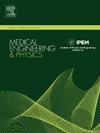Medial and lateral knee contact forces and muscle forces during sit-to-stand in patients one year after unilateral total knee arthroplasty
IF 1.7
4区 医学
Q3 ENGINEERING, BIOMEDICAL
引用次数: 0
Abstract
Understanding how forces are transmitted through the knee after TKA is essential, as it may explain why many patients experience pain or functional limitations during various activities. This study compared knee muscle forces and knee contact forces (KCF) during sit-to-stand in patients one year after unilateral total knee arthroplasty (TKA) with either a medial ball-and-socket (MBS) or posterior stabilized (PS) implant and compared them to a group of similarly healthy aged controls (CTRL). A musculoskeletal model and static optimization estimated lower limb kinematics, knee kinetics, muscle forces, and KCFs. The normalized sit-to-stand cycle was compared among the groups using statistical nonparametric mapping, and peak between-limb differences were compared using discrete statistics. The PS group required greater forward lean during the sit-to-stand task, causing greater spine flexion, posterior pelvic tilt, and decreased hip flexion on the operated limb. PS and MBS groups favoured their non-operated limb, resulting in less range of motion throughout the lower limb, lower knee kinetics, muscle forces, and KCFs on the operated limb. Compared to the controls, the MBS and PS groups had reduced medial compartment KCF. The control group did favour their dominant limb over their non-dominant limb. Post-operative rehabilitation should continue to promote greater use of the operated knee to have more symmetrical loading between operated and non-operated limbs and improve strength and mobility at the hip and ankle joints. One year after surgery, TKA patients remain with reduced muscle forces and KCF on their operated limb during a sit-to-stand task, regardless whether they received an MBS or PS implant.
单侧全膝关节置换术一年后患者坐立时膝关节内侧和外侧的接触力以及肌肉力量。
了解 TKA 术后膝关节如何受力至关重要,因为这可以解释为什么许多患者在各种活动中会感到疼痛或功能受限。本研究比较了使用内侧球窝(MBS)或后稳定(PS)假体进行单侧全膝关节置换术(TKA)一年后的患者在从坐到站过程中的膝关节肌力和膝关节接触力(KCF),并将其与一组同样健康的老年对照组(CTRL)进行了比较。肌肉骨骼模型和静态优化估算了下肢运动学、膝关节动力学、肌肉力和 KCF。使用非参数统计映射法比较了各组的归一化坐立周期,并使用离散统计法比较了肢体间的峰值差异。在坐立任务中,PS 组需要更大的前倾,导致脊柱弯曲、骨盆后倾、手术肢体的髋关节屈曲减少。PS 组和 MBS 组偏向于非手术肢体,导致手术肢体的整个下肢运动范围、膝关节动力学、肌肉力量和 KCF 值较小。与对照组相比,MBS 组和 PS 组的内侧室 KCF 有所降低。对照组的优势肢确实比非优势肢更有优势。术后康复应继续促进更多地使用手术后的膝关节,使手术后肢体和非手术后肢体的负荷更加对称,并改善髋关节和踝关节的力量和活动度。术后一年,无论接受的是 MBS 还是 PS 植入物,TKA 患者在完成坐立任务时,其手术肢体的肌肉力量和 KCF 仍会降低。
本文章由计算机程序翻译,如有差异,请以英文原文为准。
求助全文
约1分钟内获得全文
求助全文
来源期刊

Medical Engineering & Physics
工程技术-工程:生物医学
CiteScore
4.30
自引率
4.50%
发文量
172
审稿时长
3.0 months
期刊介绍:
Medical Engineering & Physics provides a forum for the publication of the latest developments in biomedical engineering, and reflects the essential multidisciplinary nature of the subject. The journal publishes in-depth critical reviews, scientific papers and technical notes. Our focus encompasses the application of the basic principles of physics and engineering to the development of medical devices and technology, with the ultimate aim of producing improvements in the quality of health care.Topics covered include biomechanics, biomaterials, mechanobiology, rehabilitation engineering, biomedical signal processing and medical device development. Medical Engineering & Physics aims to keep both engineers and clinicians abreast of the latest applications of technology to health care.
 求助内容:
求助内容: 应助结果提醒方式:
应助结果提醒方式:


